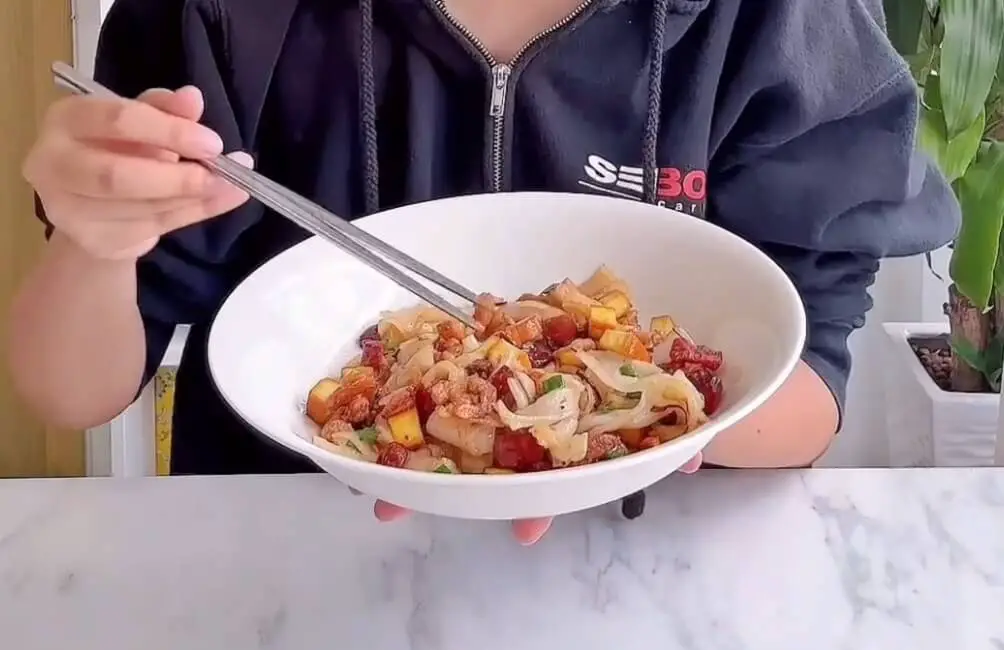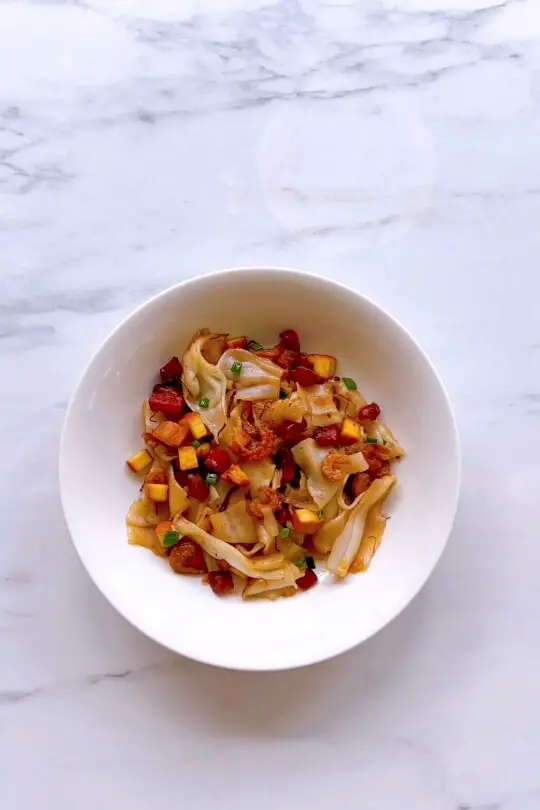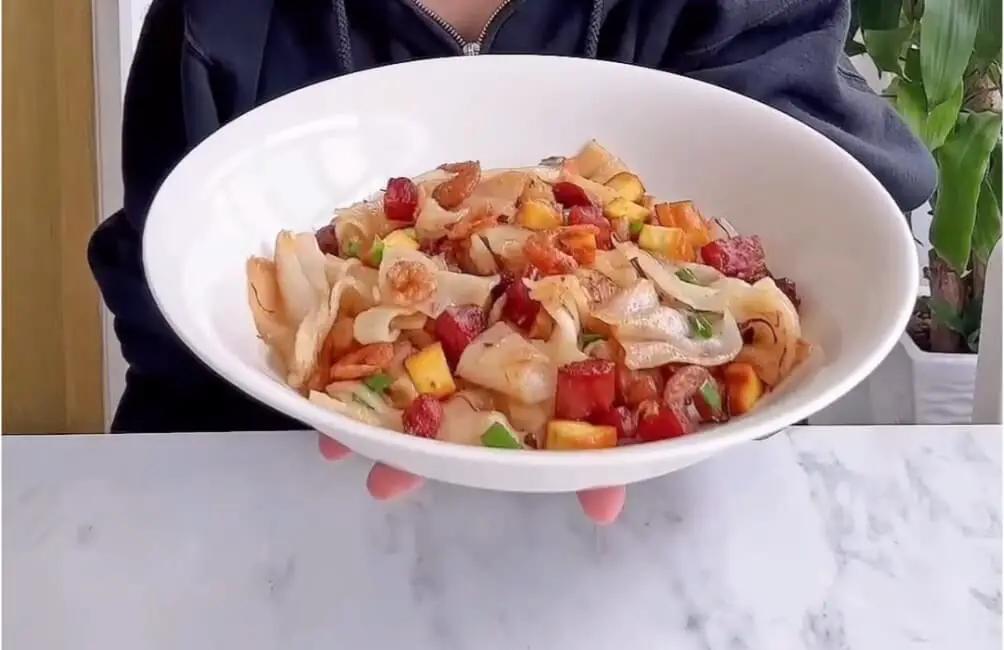Hello, I’m Scarlett And To Day We have Venture into the world of Cry Baby Noodles, a dish that beckons the brave and promises an unforgettable culinary journey. At first glance, these noodles might seem like any other, but a closer look reveals a glistening sheen of spices and sauces that hint at the fiery adventure to come. As the name suggests, Cry Baby Noodles are not for the faint-hearted. They are a symphony of spicy, tangy, and savory notes, each strand coated in a sauce that’s as fiery as it is flavorful.
With every bite in Cry Baby Noodles Recipe, there’s a burst of heat, a jolt that might just bring a tear to your eye. But it’s not just about the spice. Beneath the heat lies a complexity of flavors, a delicate balance that keeps you coming back for more. The noodles are tender, soaking up the rich sauce, while occasional garnishes add crunch and freshness, cutting through the heat. It’s a dish that challenges, surprises, and delights in equal measure.
Here’s some noodle recipes may you want to try:
- Grandma’s Chicken Noodle Soup Recipe A Classic Comfort Food
- Crack Chicken Noodle Soup: The Ultimate Comfort Dish
- Panera Chicken Noodle Soup: A Comforting Culinary Delight
Cry Baby Noodles Recipe Perfect for those who believe in pushing culinary boundaries and who love to test their spice limits, Cry Baby Noodles stand as a testament to the adage, “pain is pleasure.” So, gather your courage, take a deep breath, and dive into this roller-coaster of flavors. It’s a dish that’s sure to leave an impression, long after the last bite.

Cry Baby Noodles: Delicious Comfort Food
What are Cry Baby Noodles?
Cry Baby Noodles are a spicy noodle dish known for their intense heat and flavorful combination of ingredients. The name “Cry Baby” suggests the reaction one might have after tasting the fiery spiciness of the dish. Typically, these noodles are drenched in a spicy sauce made from a blend of chili peppers, garlic, and other seasonings, which gives them their characteristic heat.
Origin and Popularity:
The exact origin of Cry Baby Noodles is a bit ambiguous, but spicy noodle dishes have been a staple in various Asian cuisines for centuries. Countries like China, Thailand, and Korea have their own versions of spicy noodles, each with its unique flavor profile and heat level.
However, the term “Cry Baby Noodles” became particularly popular in the foodie and online community, where spicy food challenges often go viral. As people shared their experiences of trying these extremely spicy noodles, the name “Cry Baby” became synonymous with the fiery challenge of consuming them.
The popularity of spicy foods, combined with the rise of food blogging, vlogging, and social media, has contributed to the widespread recognition of Cry Baby Noodles. Many restaurants have also started to offer their own versions of this dish, catering to the adventurous palates of spice lovers.
In conclusion, Cry Baby Noodles are not just a dish; they represent a challenge, a culinary experience, and a testament to the love many have for spicy foods. Whether you’re a seasoned spice veteran or a curious newbie, Cry Baby Noodles promise an unforgettable taste experience.

Ingredients for the Perfect Cry Baby Noodles
“Cry Baby Noodles” isn’t a universally recognized dish as of my last update in January 2022. However, the name suggests something spicy or perhaps tear-inducing. Let’s create a recipe based on that concept, with essential ingredients and optional add-ons:
Cry Baby Noodles
Essential Ingredients:
- Noodles:
- 200g of your preferred noodles (e.g., ramen, udon, rice noodles, etc.)
- Spicy Sauce Base:
- 2 tbsp chili oil
- 1 tbsp soy sauce
- 1 tsp sesame oil
- 2 cloves garlic, minced
- 1 tbsp ginger, minced
- 2 tbsp chili paste (like Sambal Oelek or Sriracha)
- Proteins:
- 150g chicken, beef, or tofu, thinly sliced
- Vegetables:
- 1 bell pepper, thinly sliced
- 2 green onions, chopped
- 1 small onion, thinly sliced
- Herbs:
- A handful of fresh cilantro, chopped
- A handful of fresh basil, torn
Optional Add-ons:
- Additional Heat:
- 1-2 fresh chili peppers, sliced (e.g., bird’s eye chili, habanero, etc.)
- Extra chili paste or hot sauce to taste
- Vegetables:
- Bok choy, chopped
- Mushrooms, sliced
- Snow peas
- Bean sprouts
- Toppings:
- Soft-boiled egg
- Crushed peanuts
- Sesame seeds
- Lime wedges
- Proteins:
- Shrimp
- Pork
- Tempeh
- Flavor Enhancers:
- 1 tbsp fish sauce (for a deeper umami flavor)
- 1 tsp rice vinegar (for a tangy kick)
- 1 tsp sugar or honey (to balance the heat)
Instructions:
- Cook the noodles according to the package instructions. Drain and set aside.
- In a large pan or wok, heat the chili oil over medium heat. Add the garlic and ginger and sauté until fragrant.
- Add your choice of protein and cook until browned and cooked through.
- Add the onions and bell pepper (and any other optional vegetables) and stir-fry until they’re slightly softened.
- Mix in the chili paste, soy sauce, and sesame oil. Stir well to coat the ingredients.
- Add the cooked noodles to the pan and toss everything together until the noodles are well-coated with the sauce and the mixture is heated through.
- Serve hot, garnished with green onions, cilantro, basil, and any other desired toppings.
Feel free to adjust the heat level to your preference. The name “Cry Baby Noodles” suggests a spicy dish, but you can always tone it down or amp it up as you like!
Step-by-Step Cooking Guide For Cry Baby Noodles Recipe:
Preparing the Ingredients:
- Gather Your Ingredients:
- Noodles (e.g., spaghetti, fettuccine, ramen, or any type you prefer)
- Water
- Salt
- Optional: Olive oil or a bit of vegetable oil
- Preparation:
- Measure out the amount of noodles you want to cook. Typically, about 100-125 grams (3.5-4.4 oz) per person is a good serving size for main dishes.
- Fill a large pot with water. The amount of water will depend on the quantity of noodles you’re cooking, but a general rule is to use 4-6 quarts of water for every pound (450 grams) of pasta.
- Set out a colander or strainer in the sink for draining the noodles later.
Cooking the Noodles:
- Boil the Water:
- Place the pot of water on the stove and turn the heat to high.
- Add a generous pinch of salt to the water. This will season the noodles as they cook.
- Optional: Add a splash of oil to the water. This can help prevent the noodles from sticking together, although some purists argue it’s unnecessary.
- Adding the Noodles:
- Once the water is at a rolling boil, carefully add the noodles to the pot.
- Stir gently with a wooden spoon or pasta fork to ensure the noodles don’t stick together.
- Cooking Time:
- Follow the package instructions for the specific type of noodle you’re cooking, as cooking times can vary. If there are no instructions, here are some general guidelines:
- Spaghetti: 8-10 minutes
- Fettuccine: 10-12 minutes
- Ramen: 2-5 minutes (depending on thickness and type)
- Taste test a noodle a minute or two before the minimum recommended cooking time to check for doneness. Noodles should be “al dente” or firm to the bite, but not hard.
- Follow the package instructions for the specific type of noodle you’re cooking, as cooking times can vary. If there are no instructions, here are some general guidelines:
- Draining the Noodles:
- Once the noodles are cooked to your liking, turn off the heat.
- Carefully pour the contents of the pot into the colander or strainer you set out earlier, draining the boiling water and leaving the noodles behind.
- Optional: If you’re not using the noodles immediately, you can rinse them with cold water to stop the cooking process and prevent sticking.
- Serving:
- Transfer the drained noodles to a serving dish or mix with your desired sauce or toppings.
- Serve immediately for the best taste and texture.
Tips:
- For an extra touch, consider adding fresh herbs or grated cheese on top of your noodles.
- Always be cautious when working with boiling water to avoid burns.
- If you’re making a noodle salad or a cold noodle dish, rinsing the noodles with cold water after draining is essential to halt the cooking process and cool them down quickly.
Customizing Your Cry Baby Noodles Recipe
Cry Baby Noodles, a popular spicy noodle dish, can be easily customized to fit individual preferences. Whether you’re looking to adjust the spice level or make it suitable for vegans and vegetarians, here’s how you can tweak the recipe:
Adjusting the Spice Level:
- Chili Oil: The primary source of heat in Cry Baby Noodles is often chili oil. To increase the spice, add more chili oil. To decrease the spice, reduce the amount or use a milder chili oil.
- Fresh Chilies: If the recipe calls for fresh chilies, you can adjust the number you use. Removing the seeds and membranes from chilies will also reduce their heat.
- Chili Flakes: If you’re using dried chili flakes, the quantity can be increased or decreased based on your preference.
- Taste as You Go: Always taste the sauce before mixing it with the noodles. This way, you can adjust the spice level before it’s too late.
Vegan and Vegetarian Variations For Cry Baby Noodles Recipe:
- Protein Substitute:
- Vegetarian: If the original recipe calls for meat, you can replace it with tofu, tempeh, or even paneer (Indian cheese) for a vegetarian version.
- Vegan: For a vegan option, use firm tofu, tempeh, or seitan. Make sure to marinate or season them well to infuse flavor.
- Broth:
- If the recipe requires a meat-based broth, substitute it with a vegetable broth for both vegan and vegetarian versions.
- Eggs:
- If the recipe includes eggs, vegans can omit them or use vegan-friendly alternatives like tofu scramble.
- Sauces and Condiments:
- Ensure that any sauces or condiments used are vegan or vegetarian. For instance, traditional fish sauce can be replaced with a vegan fish sauce or soy sauce.
- Toppings:
- Opt for vegan or vegetarian toppings. Examples include sautéed mushrooms, steamed bok choy, roasted bell peppers, or blanched bean sprouts.
- Check Noodles:
- Ensure the noodles you’re using don’t contain any egg or other non-vegan ingredients. There are plenty of vegan noodle options available in stores.
Remember, the beauty of cooking is that you can always adjust recipes to fit your personal preferences and dietary needs. Experiment and find the perfect balance that suits your palate!
Health Benefits of Cry Baby Noodles Recipe
“Cry Baby Noodles” is not a widely recognized or standard food item. It’s possible that it’s a new or niche product, a regional specialty, or perhaps a colloquial name for a type of noodle or dish. Without specific information about the ingredients and preparation of “Cry Baby Noodles,” it’s challenging to provide detailed health benefits, nutritional value, or dietary considerations.
However, I can provide a general overview based on the assumption that “Cry Baby Noodles” are a type of noodle dish:
Health Benefits of Noodles:
- Energy Source: Noodles, like other carbohydrate-rich foods, provide a quick source of energy.
- Protein: Some noodles, especially those made from whole grains or legumes, can be a good source of protein.
- Dietary Fiber: Whole grain noodles or those made from alternative flours (like buckwheat or quinoa) can be a source of dietary fiber, which aids in digestion.
Nutritional Value:
- Carbohydrates: Noodles are primarily a source of carbohydrates.
- Protein: The protein content varies based on the type of noodle. For instance, egg noodles will have a higher protein content than rice noodles.
- Micronutrients: The nutritional value in terms of vitamins and minerals will largely depend on the ingredients used. Whole grain noodles might contain more B vitamins and minerals like iron and magnesium compared to refined noodles.
Dietary Considerations:
- Gluten: Those with celiac disease or gluten sensitivity should opt for gluten-free noodles, such as rice noodles or noodles made from gluten-free grains.
- Calories: Noodles can be calorie-dense, especially when cooked with rich sauces or oils. It’s essential to be mindful of portion sizes.
- Sodium: Many noodle dishes, especially those that come with sauces or are served in broths, can be high in sodium. It’s crucial to watch sodium intake, especially for those with hypertension or other heart-related conditions.
- Additives and Preservatives: Some commercially produced noodles might contain additives or preservatives. Always check the label if you have specific dietary concerns.
FAQ For Cry Baby Noodles recipe
Cry Baby Noodles are a fictional product, as of my last update in January 2022. If they have become a real product or brand after this time, I would not have information on them. However, for the sake of this FAQ, let’s assume they are a spicy noodle dish known for their intense heat.
The name “Cry Baby” suggests that the noodles are so spicy that they can make you cry, emphasizing their intense heat and flavor.
Cry Baby Noodles are known for their extreme spiciness. However, the exact level of heat can vary depending on the recipe or brand. Always check the packaging or menu description for specific heat levels.
While the specific ingredients can vary, typical ingredients for spicy noodles might include: noodles (wheat or rice), chili peppers, chili oil, garlic, soy sauce, vinegar, and various spices. Always check the ingredient list for specific details.
Common allergens in noodle dishes can include wheat (in the noodles) and soy (in the sauce). However, it’s essential to check the ingredient list or ask the manufacturer or restaurant for specific allergen information.
If Cry Baby Noodles are a packaged product, follow the instructions on the packaging. If making from scratch, you would typically boil the noodles, prepare the spicy sauce separately, and then combine them.
Yes, you can adjust the amount of chili or spicy ingredients to suit your taste. Adding ingredients like sugar, dairy, or acid (like lime juice) can also help balance out the heat.
This depends on the specific recipe or brand. Some might contain animal-derived ingredients like chicken stock or fish sauce. Always check the ingredient list or ask the manufacturer or restaurant.

Cry Baby Noodles Recipe
“Cry Baby Noodles” isn’t a universally recognized dish, but it sounds like it could be a spicy noodle dish based on the name. Here’s a spicy noodle recipe inspired by the name “Cry Baby Noodles”. Feel free to adjust the spiciness according to your preference.
Ingredients
- Large Pot: For boiling the noodles.
- Colander or Strainer: To drain the noodles once cooked.
- Knife and Cutting Board: For chopping ingredients such as vegetables, garlic, ginger, and proteins (like chicken, beef, or tofu).
- Measuring Cups and Spoons: For measuring out ingredients accurately.
- Mixing Bowls: Useful for mixing sauce ingredients or marinating proteins.
- Stirring Spoon or Tongs: For stirring the noodles and ingredients together.
- Frying Pan or Wok: For stir-frying the noodles and other ingredients.
- Grater or Zester: Useful if the recipe calls for zested or finely grated ingredients like ginger or lemon zest.
- Garlic Press (optional): If you want finely crushed garlic without chopping.
- Mortar and Pestle or Spice Grinder (optional): For grinding fresh spices if the recipe calls for it.
- Thermometer (optional): Useful if frying or wanting to ensure meats are cooked to the correct temperature
- 400 g of your favorite noodles (e.g., ramen, udon, rice noodles)
- 3 tablespoons sesame oil
- 4 cloves garlic (minced)
- 1 tablespoon ginger (minced)
- 2-3 red chili peppers (finely sliced (adjust based on your heat preference))
- 3 tablespoons soy sauce
- 1 tablespoon oyster sauce (optional)
- 2 tablespoons chili oil (or to taste)
- 1 tablespoon rice vinegar
- 1 tablespoon sugar
- 2 spring onions (sliced)
- 1 red bell pepper (thinly sliced)
- 100 g bean sprouts
- Fresh coriander (cilantro for garnish)
- Toasted sesame seeds for garnish
Preparations
- Prepare the Noodles: Cook the noodles according to the package instructions until al dente. Drain and set aside.
- Sauté Vegetables: In a large pan or wok, heat the sesame oil over medium heat. Add the minced garlic, ginger, and sliced chili peppers. Sauté for 2-3 minutes until fragrant.
- Add Bell Pepper: Toss in the thinly sliced red bell pepper and stir-fry for another 2 minutes.
- Sauce: In a small bowl, mix together the soy sauce, oyster sauce (if using), chili oil, rice vinegar, and sugar. Stir until the sugar is dissolved.
- Combine: Pour the sauce mixture into the pan with the sautéed vegetables. Stir well to combine.
- Add Noodles: Toss in the cooked noodles and mix well, ensuring the noodles are well coated with the sauce and combined with the vegetables.
- Final Touches: Add the bean sprouts and spring onions. Stir-fry for another 2 minutes. The bean sprouts should remain crunchy.
- Serve: Divide the noodles among serving bowls. Garnish with fresh coriander (cilantro) and toasted sesame seeds.
- Enjoy: Serve hot and enjoy your Cry Baby Noodles!
You can add protein like chicken, beef, tofu, or shrimp if desired. Just cook the protein first, set it aside, and then add it back when combining everything.
Remember, the spiciness can be adjusted based on the amount of chili oil and red chili peppers you use. Adjust according to your preference and enjoy!


2 thoughts on “Cry Baby Noodles Recipe: Delight in Every Bite!”